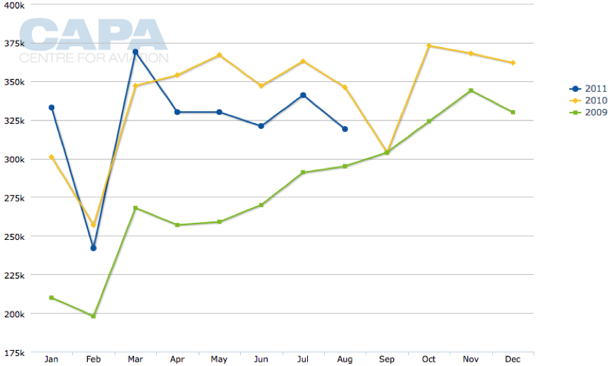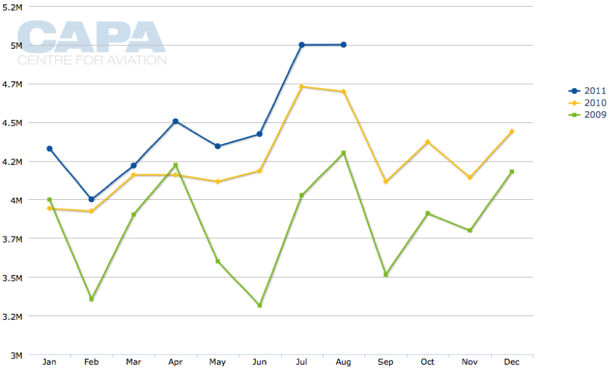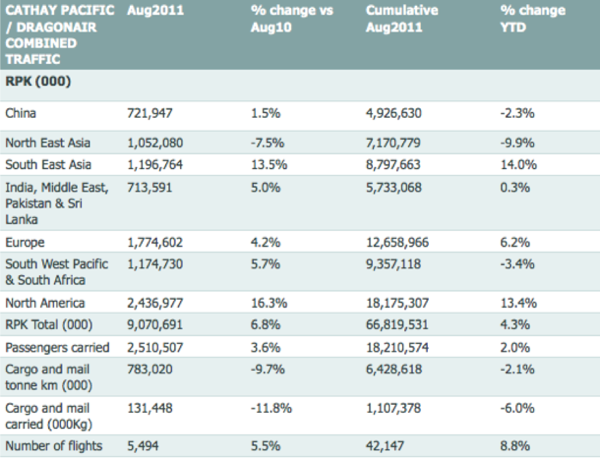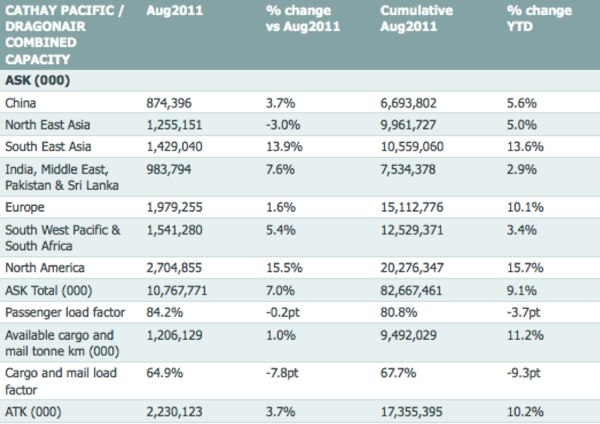Freight volumes decline dramatically to/from Hong Kong reflecting global freight trends
Cathay Pacific, Hong Kong International Airport, Asia Airfreight Terminal (AAT) and Hong Kong Air Cargo Terminals Limited's (HACTL) respective Aug-2011 traffic results revealed two distinctive trends: Passenger traffic to/from Hong Kong remained strong over the summer peak while the weakness in the freight market continued in the month.
The situation in Hong Kong is playing out elsewhere. According to IATA said recently that global freight markets are expected to remain weak throughout the remainder of the year, although a pick-up is likely in the lead up to the Christmas period.
The global air freight market (domestic and international) is now around 10% weaker than pre-recession levels, driven by domestic declines, IATA said.
The past few years have highlighted the financial volatility and the susceptibility of air freight to worldwide economic conditions. The sector witnessed a massive slump in demand in 2008, followed by a sharp rebound in 2009 and 1H2010, before trending to a steady decline from 3Q2010 into 2011. As noted by Cathay Pacific CEO John Slosar in the Aug-2011 edition of staff magazine CX World, the current "financial and economic whirlwind" is a "stark reminder that we can't take anything for granted".
While a pick-up in the lead-up to Christmas is anticipated, concerns remain about the arrival of new capacity, ordered during the pre-2008 boom and occurring amid the introduction of three new widebody cargo aircraft models (the B777F in 2009, the A320-200F in 2010 and the B747-8F this year).
A brief consumer confidence snapshot
According to The Conference Board last month, US consumer confidence "deteriorated sharply in August, as consumers grew significantly more pessimistic about the short-term outlook. The index is now at its lowest level in more than two years." Indicators measuring CEO confidence and employment trends also weakened.
The European Commission Economic and Finance Affairs similarly stated the Economic Sentiment Indicator (ESI) declined by 5.0 points to 97.3 in the EU and by 4.7 points to 98.3 in the euro area in Aug-2011. "This decline resulted from a broad-based deterioration in sentiment across the sectors, with losses in confidence being particularly marked in services, retail trade and among consumers", it said.
Japanese consumer confidence was steady in Aug-2011 after rising in the previous three months, as the economy continued to recover from the 11-Mar-2011 earthquake, the Japanese Cabinet Office said this month. Concerns centre around faltering global growth and concerns that a strong yen may dampen private spending in coming months.
Meanwhile, Chinese consumer sentiment among households, entrepreneurs and bankers weakened in the most recent quarter, according to a survey by the People's Bank of China released this month. Concerns focus around the expected monetary-policy tightening by Beijing, with interest rates set to rise in 4Q2011, while income and job expectations also declined.
Cathay Pacific cargo volume down on both 2010 and 2009 levels in Aug-2011; gradual improvement expected over coming weeks
Cathay Pacific last month stated it expects its freight business to slow in 3Q2011 as a result of economic uncertainties. The carrier stated the cargo business performed "reasonably" in the first quarter of the year, but was appreciably weaker in the second quarter. Cathay noted that demand for cargo shipments from its two main markets, Hong Kong and mainland China, was weaker than expected in the second quarter.
Moving into the third quarter and Cathay's overall cargo and mail tonnage showed a significant decline in Aug-2011 compared to 2010 levels. The market from Asia to Europe and trans-Pacific remained weak, though "intra-Asia continued to perform solidly", according to GM Cargo Sales and Marketing James Woodrow. Meanwhile, additional freighter frequencies to Australia were added for Sep-2011 due to strong imports driven by the strong Australian dollar.
Cathay Pacific and Dragonair combined reported a fifth consecutive month of cargo volume reductions. The carriers handled 131,448 tonnes of cargo and mail in Aug-2011, an 11.8% year-on-year decline - to be marginally weaker than the Aug-2009 level. According to Mr Woodrow, "the first half of September overall remained soft as expected, though tonnages should start to gradually improve over the coming weeks."
Cathay Pacific cargo volume (kg, mill): 2009 to 2011

Cathay Pacific's cargo and mail load factor also weakened notably in Aug-2011, down 7.8 ppts to 64.9%, marking the 12th consecutive month of year-on-year cargo load factor declines. Cargo load factors have been weaker than both 2010 and 2009 levels for three consecutive months.
Cathay Pacific cargo load factor (%): 2009 to 2011

The significant load factor weakness occurred as cargo capacity (available cargo/mail tonne kilometres) increased 1%, marking the 18th consecutive month of capacity growth, compared to a 9.7% reduction in traffic (cargo and mail tonne kilometres flown). Cargo traffic has declined on a year-on-year basis for the past five months, but remains stronger compared to 2009 levels.
Cathay Pacific Revenue Freight Tonne Kilometres (mill): 2009 to 2011

Cathay Pacific Available Freight Tonne Kilometres (bill): 2009 to 2011

Strong traffic growth in summer peak for Cathay Pacific. Yields continue strong performance
It was however a different story for passenger traffic at Cathay Pacific. Traffic remained strong in the summer peak, with the increase in traffic (RPKs) in line with capacity (ASKs) growth.
"We continued to see a strong performance in the region, in particular from Southeast Asia, South Korea and the secondary Chinese cities, though demand in the Middle East remained weak. Our premium traffic continued to have a strong performance and we are seeing good growth in terms of both volume and yield," Cathay Pacific GM Revenue Management James Tong said.
The carrier has separately stated that demand for economy class seats was slightly less than expected. Demand for premium class seats remained strong, despite economic uncertainties in a number of world economies. Yields rose in both first and business classes
Cathay Pacific and Dragonair combined handled 2.5 million passengers in Ag-2011, a 3.6% year-on-year increase, and load factors averaged 84.2%, a 0.2 ppt year-on-year decline.
Cathay Pacific passenger numbers (mill): 2009 to 2011

Cathay Pacific Airways Passenger Load Factor (2009 to 2011)

Cathay Pacific CEO John Slosar in late Aug-2011 stated Cathay has no plans to delay new aircraft as Asia is avoiding the worst of the global economic slowdown. The carrier is scheduled to receive eight new aircraft, including five freighters, in 2H2011, followed by 16 new aircraft in 2012. Cathay is "still pretty confident" about the outlook, Mr Slosar said.
Hong Kong International Airport reports cargo decline
Hong Kong International Airport (HKIA) similarly noted a 7.8% year-on-year decline in cargo levels in Aug-2011 to 319,000 tonnes, reflecting weaker economic conditions in the US and Europe.
Hong Kong International Airport Air Cargo (tonnes, '000s): 2009 to 2011

The cargo declines were mainly attributed to an 11% year-on-year drop in export volume. Imports and transshipments also declined, by 5% and 1% respectively. Europe, North America, Taiwan and Japan experienced double-digit year-on-year decreases in overall cargo traffic.
Hong Kong International Airport reports record passenger traffic in Aug-2011
On a more positive note, HKIA reported another busy month for passenger traffic, with passenger traffic and flight movements setting new monthly records in Aug-2011. Fuelled by the burgeoning demand during the traditional summer peak season, passenger traffic continued its upswing, registering a year-on-year growth of 6.5% to a new record high of 5 million.
Hong Kong International Airport passenger numbers (mill): 2009 to 2011

The growth in passenger traffic in Aug-2011 was mainly driven by visitors' traffic and transfer/transit passengers which saw growth of 10% and 8% respectively over the same period last year. Passenger traffic to/from South East Asia performed particularly well.
During the month, flight movements also reached a new high of 28,940, up 6.7% year on year, breaking the previous record made in Mar-2011.
Hong Kong International Airport aircraft movements ('000s): 2009 to 2011

Airport Authority Hong Kong CEO Stanley Hui Hon-chung stated the airport has seen continuous growth in passengers using the cross-boundary transport. During the month, a new high of more than 249,000 passengers used the ferry services at the SkyPier connecting HKIA to eight ports in the Pearl River Delta, which represented a year-on-year growth of 11%. Mr Hui added that the growth momentum in passenger traffic at HKIA would continue as another travel peak is anticipated during the National Day Golden Week holidays.
AAT and HACTL report declined in cargo traffic. Export cargo hit the hardest. Transshipment levels increase
Asia Airfreight Terminal Co Ltd (AAT) stated tonnage throughput in Aug-2011 fell 8% to 55,203 tonnes. Export cargo registered 38,260 tonnes, a decline of 12% year-on-year. Import cargo volume weakened slightly, by 0.3% to 16,133 tonnes. Trans-shipment cargo volume was 811 tonnes, a 68% year-on-year increase.
Commenting on the result, AAT General Manager for Corporate Development, Kenneth Yeung said, "Although export has been affected by the US and European economy, import growth has been more encouraging. Maybe a sign of more balanced trade."
Hong Kong Air Cargo Terminals Limited (Hactl) similarly reported a 9.3% year-on-year decline in air cargo tonnage throughput for Aug-2011 to 221,375 tonnes. Export volume in Aug-2011 slumped 13.3% to 117,771 tonnes and import volumes declined 8.9% to 55,345 tonnes. The transshipment volume was 48,259 tonnes in Aug-2011, to be the only growth area (+1.7%).
Outlook: Freight weakness a concern
The positive passenger traffic results in the peak month of Aug-2011 provided some welcome news for Cathay Pacific and Hong Kong International Airport amid an increasingly weak cargo sector. While cargo volumes traditionally pick-up ahead of the Christmas peak, an increasing and continued imbalance between capacity and demand is a challenge for freight operators worldwide. This combination of plentiful capacity and weak export demand from China could spell trouble for cargo load factors, yields and profitability in the months ahead.
APPENDIX:
Cathay Pacific Aug-2011 traffic highlights

Cathay Pacific Aug-2011 traffic highlights

Hong Kong International Airport (HKIA) traffic highlights for Aug-2011

Asia Airfreight Terminal Co Ltd traffic highlights for eight months to Aug-2011

Hong Kong Air Cargo Terminals Limited (Hactl) traffic highlights for Aug-2011
